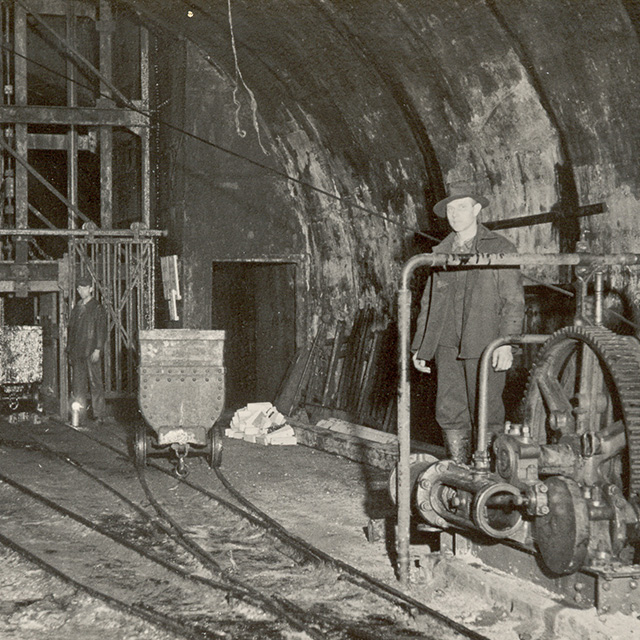The history of our oil refinery in Hemmingstedt Mineral oil –
Although Raffinerie Heide has only existed in its present form since 2010, our history actually began over 150 years ago, when oil-bearing sands were discovered in Hemmingstedt.
In this timeline we drill down into the depths of the history of mineral oil in Dithmarschen and one of the most important oil refineries in Germany.
1856
Farmer Peter Reimers discovers oil-bearing sands on his land.
1858
Heide Asphalt Mining and Lighting Oil Factory (Asphaltgrube und Photogen-Fabrik zu Heide) is founded (and later closes its doors in 1866 due to severe competition from the USA).
1865
Entdeckung eines großen Ölkreidelagers in 160 m Tiefe. Geschätzter Ölkreidevorrat: 15 Millionen Tonnen.
1880
An oil mining company is founded to extract Heide oil chalk.
1919
DPAG, a subsidiary of DEA which was founded in 1911, becomes the new owner of the oil chalk mining operations.
1922
The company is renamed Holsteinische Erdölwerke GmbH. DPAG remains the majority shareholder.
1935
Breakthrough in schleswig-holstein’s oil production history
The Holstein 2 borehole hits liquid oil at a depth of 400 metres.
By 1940 annual production rises to 231,347 tonnes.
1940
Raffinerie Heide operations begin. The German navy’s demand for fuel gives impetus for the construction of the first non-stop crude oil distillation operation in Hemmingstedt. Two crude oil distillation plants are built with an annual capacity of 100,000 tonnes.
1944
The refinery is destroyed by repeated bombing raids.
1947
Installations which are still able to be used are rebuilt.
1949
Mining operations and oil chalk extraction come to an end in Heide. Conversion to refinery-only operation begins.
1952
Germany’s first thermal catalytic cracking plant is commissioned
1953
The first crude oil pipeline is built between Brunsbüttel and Hemmingstedt, with a capacity of 1.5 million tonnes of crude oil a year.
1956
The first petrochemical plant (aromatics) is commissioned.
1967
Operations are taken over by Texaco AG
1973
A further crude oil and vacuum distillation plant with sulphur recovery unit are commissioned, bringing the refinery’s capacity to 5.6 million tonnes of crude oil a year. However, due to the impending oil crisis, this output is never again reached.
1976
Two pipelines supply Hemmingstedt’s municipal swimming pool with free water heated to 45ºC, allowing the entry price to be reduced.
1980
A plant built to produce high-octane petrol means that lead no longer has to be added to inhibit knocking.
1987
A thermal pre-treatment plant reduces the amount of non-reusable heavy heating oil burnt at the plant.
1988
Energy company RWE takes over Deutsche Texaco AG in June. The Petroleum division of the Group – and thus Raffinerie Heide – trades under the name RWE Dea AG from now on.
1989
Additional desulphurisation plants improve air quality in the Dithmarschen district..
1998
The plant is completely modernised. A newly built hydrocracker permits previously unseen levels of product yield. Meanwhile, further construction work leads to a major improvement in Raffinerie Heide’s. petrochemical range.
2002
DEA Mineralöl GmbH and Shell Deutschland Oil GmbH run the refinery as a joint venture.
2004
Shell Germany Oil GmbH becomes the new sole owner. Major investments in safety and production make the refinery one of the most modern installations in Europe.
2009
The refinery begins using its superfluous exhaust heat to supply Gewerbepark Westküste, the neighbouring business park, with heating. This enables the company Vitarom Frischgemüse GmbH to heat its greenhouses to the right growing and harvesting temperatures for their 185,000 bell pepper and tomato plants. In other words, the heat we supply is responsible for creating new jobs in the Schleswig-Holstein region.
2010
Raffinerie Heide is taken over by the Klesch Group. Wide-ranging restructuring of our production and administration activities ensures that the refinery will be well placed in future to focus on its role as a supplier for northern Germany, delivering products precisely tailored to the needs of local consumers and businesses.
2015
The company makes a successful transition to independence.
Raffinerie Heide successfully expands its business and makes considerable progress in terms of crude oil selection, yield structure and customer focus.
2018
As part of the KEROSyN100 research project,
we are working with seven project partners from research and industry to bring synthetic kerosene based on electricity from renewable energies closer to a market launch.
2020
As one of the partners in the WESTKÜSTE100 project,
we are taking the right step towards climate protection and a green future. The planning phase for the construction of a 30 MW electrolysis plant for the production of green hydrogen on the refinery site has begun with the funding commitment from the Federal Ministry of Economics as part of the “real laboratories of the energy transition”.
2021
Another milestone in the WESTKÜSTE100 project:
The BMWi grants funding for the upgrading of a cavern for storing green hydrogen. Another important step in advancing the energy transition and decarbonization.
The Pioneer
The Pioneer
Dr. Ludwig Meyn
Born in 1820 in Pinneberg, Germany, Dr Meyn was the son of a doctor.
He studied natural sciences in Berlin from 1840 and worked as a private lecturer in mineralogy and soil science.
In 1856 he initiated the first targeted oil drilling in Germany, working in Lieth in the Dithmarschen district.
He heated up bituminous sands to produce heavy oil and distilled kerosene from this.
In 1865 he discovered a Cretaceous oil deposit at a depth of 160 m.
Dr Meyn died in Hamburg in 1878.
Figures and statistics
for Raffinerie Heide
All key data and facts & figures
for the refinery at a glance
We are pleased to present an overview of the most relevant figures and statistics for Raffinerie Heide in this section, as well as further information on the following pages (e.g. Products, Responsibility and Careers).
- Middle distillates refinery with a major petrochemicals focus
- Part of the Klesch Group since 2010
- Total capacity 4.5 million tonnes per year
- Processor of crude oil from global and domestic sources
- Our own power station outputs 46.5 MW of electricity
- 3.8 billion euros turnover (2022)
- 35.0 million euros in investment (2022)
- 520 employees
- 30 trainees in two trades (75% male and 25% female)
- More than 50% of our employees have been with us for at least 20 years
- Average age ~ 43
- At any one time around 250 employees from partner companies work at Raffinerie Heide
Crude oil supply
Crude oil comes from Germany’s Mittelplate offshore oil field and all round the world. The oil is delivered via the 32-km pipeline from Brunsbüttel to Hemmingstedt.
Raffinerie Heide’s tank farm capacity in Hemmingstedt and Brunsbüttel
Heide 460.000 m³
Brunsbüttel 510.000 m³
Total 970.000 m³
Size of Raffinerie Heide
Site area 134 hectares



